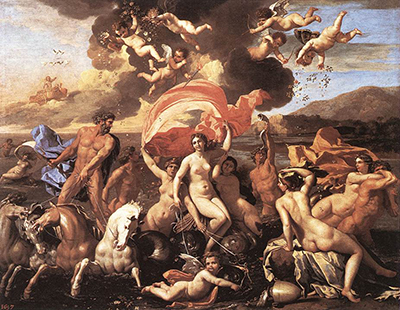The Triumph of Neptune by French baroque painter Nicolas Poussin was created in 1634. The oil on canvas painting is found at the Philadelphia Museum of Art. It is one of the most important works by Poussin found in the United States.
Subject to many interpretations, the painting was likely painted for or commissioned by Cardinal Richelieu. An example of the Classicism art style, the painting is influenced by Raphael's fresco in the Villa Farnese and images of gods found in antiquity. A popular interpretation is that the work represents the mythology surrounding Neptune and his wife Amphitrite. Another interpretation of the painting is the birth of terrestrial Venus. Under the more common interpretation, the scene depicts the return of Amphitrite to Neptune. When Amphitrite escaped from Neptune's courting, he sent dolphins to persuade her to return and become his bride. In the painting, the goddess Amphitrite rides on a dolphin's back next to Neptune's chariot.
The dramatic scene depicts a tempest with dark clouds on a sunny day, with the painting’s characters in the sea and a mountainous coast in the background. Drapery swirls over the goddess's head, while Tritons or mermen and Nereids or sea-nymphs surround her and Neptune. The Tritons are depicted blowing horns and the Nereid holds the blowing pink scarf that flows over the goddess's head. Cupids are also seen scattering flowers and leaves, and nude women sit by a gushing vase in the foreground. One cupid aims a bow at Neptune. In the sky, a chariot and the goddess of love Aphrodite are visible. The imagery of love, including roses and myrtle, lean towards the interpretation of the painting symbolising the marriage of Neptune and Amphitrite.
The Triumph of Neptune was created during a transitional period for Poussin. During the late 1620s and early 1630s, the artist was known for creating vivid painting during his first residence in Rome. His paintings often featured a bright pallet and warm tones during this period. Into the 1640s, the painter adopted a more classical style that can be seen in The Triumph of Neptune. The poses and movements of Neptune and Amphitrite, for example, are reminiscent of those found in sculptures from ancient Greece and Rome.




